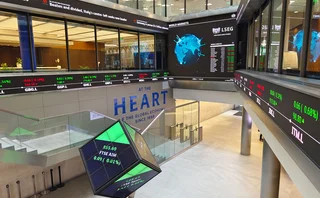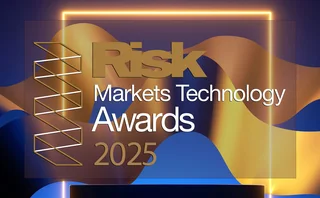
Investment product of the year: Credit Agricole
Risk 2020: CMS 10-10 gives FRNs a much-needed coupon lift

Credit Agricole revived a lifeless market for floating rate notes this year.
The bank solved a structural problem that had squeezed coupons on floating rate notes (FRNs) a percentage point lower than equivalent tenor fixed-rate bonds and had choked issuance from tens of billions of euros a year to almost zero.
The new structure pegged FRN coupons to forward rather than spot rates, eliminating a negative carry that had dragged down coupons in the old structure. Fourteen other issuers have since adopted the format, issuing more than €2.8 billion since November 2018.
“The floating rate note market had almost disappeared,” says Amaury D’Orsay, the bank’s global head of fixed income sales. “In a year of all-time low and falling rates, the development of the ‘10-10’ structure brought it back to €3 billion in less than a year. This is not just a product. It has become a market.”
Financial institutions typically use FRNs to protect against interest rate rises, principally the risk that customers withdraw savings when rates go up and leave institutions with depleted assets to match their liabilities. Credit Agricole estimates total outstanding issuance to be about €200 billion. But volumes in the three years to 2019 amounted to no more than €3 billion.
Usually the notes pay a coupon based on the 10-year constant maturity swap (CMS) rate or three-month Euribor, plus or minus a spread. In essence, the investor buys an expensive forward rate and receives a cheaper spot rate. The negative carry delivers a lower coupon. The further the forward curve rises above spot rates, the lower the first coupon will be compared to the equivalent fixed rate.
Twenty-year investment grade FRNs today in Europe would typically pay a zero coupon if linked to three-month Euribor, explains Christophe Viard, Credit Agricole’s head of macro structuring.
Poor returns from holding FRNs were taken as fact by clients, D’Orsay says: “Everyone accepted floating rate notes were expensive. They just didn’t buy them.”
Through more than 200 meetings since the beginning of 2018, the bank explained its new structure to clients, culminating in an initial €100 million 20-year deal sold to a French mutual insurer in November 2018. Since then, Credit Agricole has issued a further €600 million in 14 deals – about 25% of the FRN issuance in the new format by volume.
To solve FRNs’ carry problem, Credit Agricole took advantage of a structural downward slope in the forward curve after the 10-year point. That means the gap between the forward and spot curve closes. By indexing bonds to a 10y10y forward swap, the bank removed the drag on the coupon.
This is not just a product. It has become a market
Amaury D’Orsay, Credit Agricole
“The CMS 10-10 exposure will give at least the fixed rate equivalent coupon. With any other floating rate exposure, you reduce your coupon,” says Viard.
The flattening of the forward curve results from the convexity of long-dated swaps and bonds, which are more sensitive to rate changes than shorter-dated bonds. At the long end, the downward pull of convexity cancels out an otherwise natural upward slope. For euro and US dollar interest rates this inflexion point falls at 10 years 80–90% of the time.
“Nobody had thought of this before,” says a former finance director at the French mutual. Credit Agricole’s quantitative simulations showed 10-years was the optimum point of the curve, he says. “I realised that CMS10 in 10 years would become a kind of new market reference.”
A critical step in the successful take-up was the publication of the bank’s formula for calculating coupons. The formula draws a relationship between spot and forward rates, providing a “really good proxy” for the physical forward rate at any point in time.
In broad terms, a 20-year swap can be thought of as a 10-year swap and a 10y10y swap. That means you have a relationship between the 20-year, the 10y10y and the 10-year and can calculate one from the others, explains Samy Ben Aoun, global head of structured rates trading.

“If you want to develop a concept in the fixed income world you have to be completely transparent on the calculation of the coupon. If investors could not compute the coupon, they would not buy the product because they would be relying only on the fairness of the manufacturer to determine the rate.”
Even so, in several cases the bank held more than 10 meetings with a single client to explain the structure before striking a deal. Part of the exercise was talking through potential vulnerabilities, though there have been only 17 days since 2000 that the 10y10y rate would have fared worse than the 10-year.
“If there were an inversion of the curve between the 10-year and 20-year points you could underperform versus a conventional FRN,” says Ghyslain Ladret, global head of macro structuring at Credit Agricole.
But the “first risk” in holding FRNs is the level of rates, he says. “And each time we’ve seen an inversion in the past it was a bear market yield-curve flattening scenario and rates were high. In that scenario, you’d expect investors to be still quite happy with a 4.5% yield instead of 5%.”
Ladret says the principle of indexing to forward rates can be applied in other asset classes. Already the bank is applying the idea in foreign exchange.
“This is not just tweaking a payoff. This is making possible an indexation to forward rates. Other asset class specialists could benefit from similar properties as long they understand the concept,” he says. “That is our next target.”
Only users who have a paid subscription or are part of a corporate subscription are able to print or copy content.
To access these options, along with all other subscription benefits, please contact info@risk.net or view our subscription options here: http://subscriptions.risk.net/subscribe
You are currently unable to print this content. Please contact info@risk.net to find out more.
You are currently unable to copy this content. Please contact info@risk.net to find out more.
Copyright Infopro Digital Limited. All rights reserved.
As outlined in our terms and conditions, https://www.infopro-digital.com/terms-and-conditions/subscriptions/ (point 2.4), printing is limited to a single copy.
If you would like to purchase additional rights please email info@risk.net
Copyright Infopro Digital Limited. All rights reserved.
You may share this content using our article tools. As outlined in our terms and conditions, https://www.infopro-digital.com/terms-and-conditions/subscriptions/ (clause 2.4), an Authorised User may only make one copy of the materials for their own personal use. You must also comply with the restrictions in clause 2.5.
If you would like to purchase additional rights please email info@risk.net
More on Awards
Clearing house of the year: LCH
Risk Awards 2025: LCH outshines rivals in its commitment to innovation and co-operation with clearing members
Best use of machine learning/AI: CompatibL
CompatibL won Best use of machine learning/AI at the 2025 Risk Markets Technology Awards for its use of LLMs for automated trade entry, redefining speed and reliability in what-if analytics
Markets Technology Awards 2025 winners’ review
Vendors jockeying for position in this year’s MTAs, as banks and regulators take aim at counterparty blind spots
Equity derivatives house of the year: Bank of America
Risk Awards 2025: Bank gains plaudits – and profits – with enhanced product range, including new variants of short-vol structures and equity dispersion
Law firm of the year: Linklaters
Risk Awards 2025: Law firm’s work helped buttress markets for credit derivatives, clearing and digital assets
Derivatives house of the year: UBS
Risk Awards 2025: Mega-merger expected to add $1 billion to markets revenues, via 30 integration projects
Interest rate derivatives house of the year: JP Morgan
Risk Awards 2025: Steepener hedges and Spire novations helped clients navigate shifting rates regime
Currency derivatives house of the year: UBS
Risk Awards 2025: Access to wealth management client base helped Swiss bank to recycle volatility and provide accurate pricing for a range of FX structures







